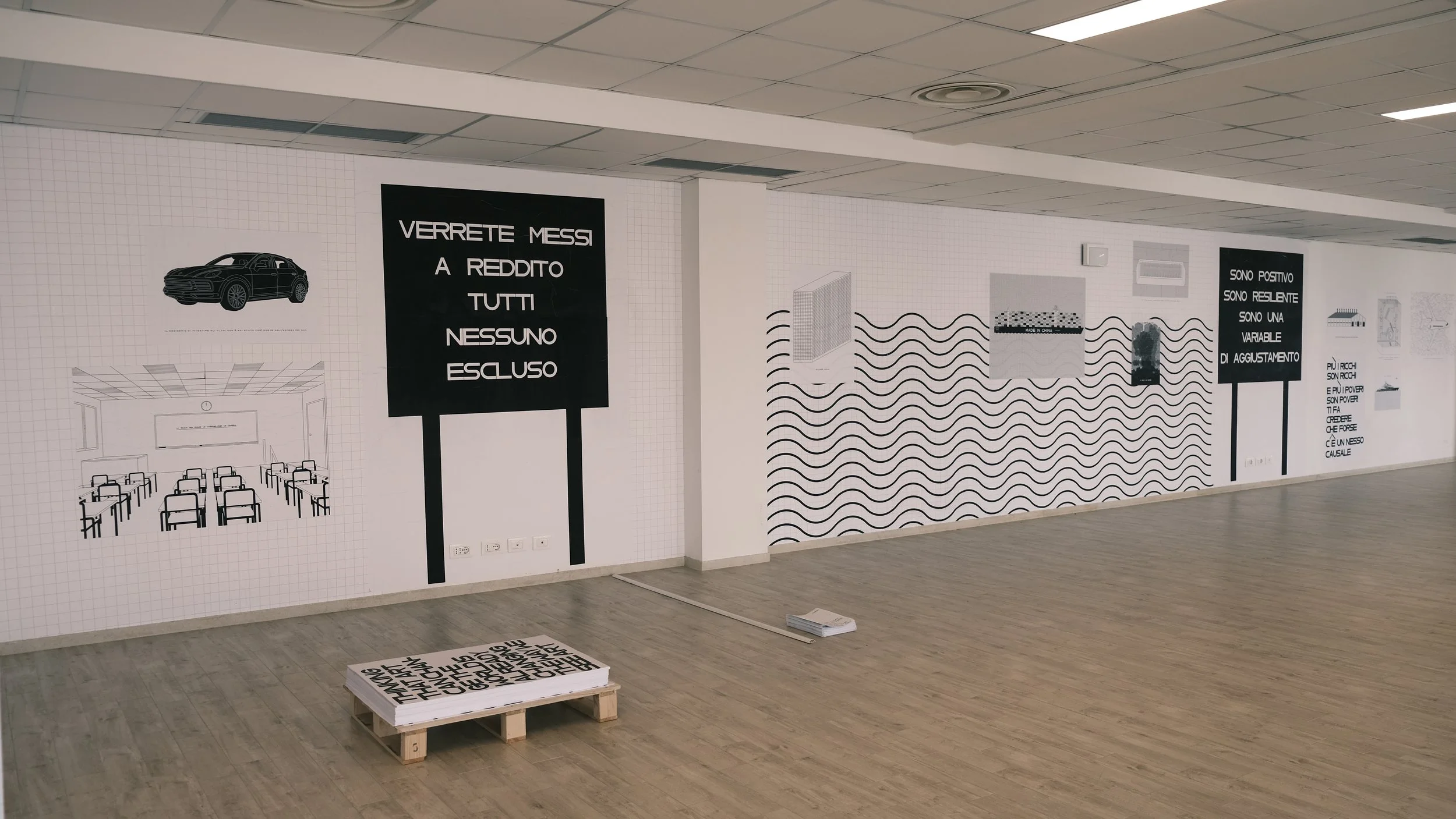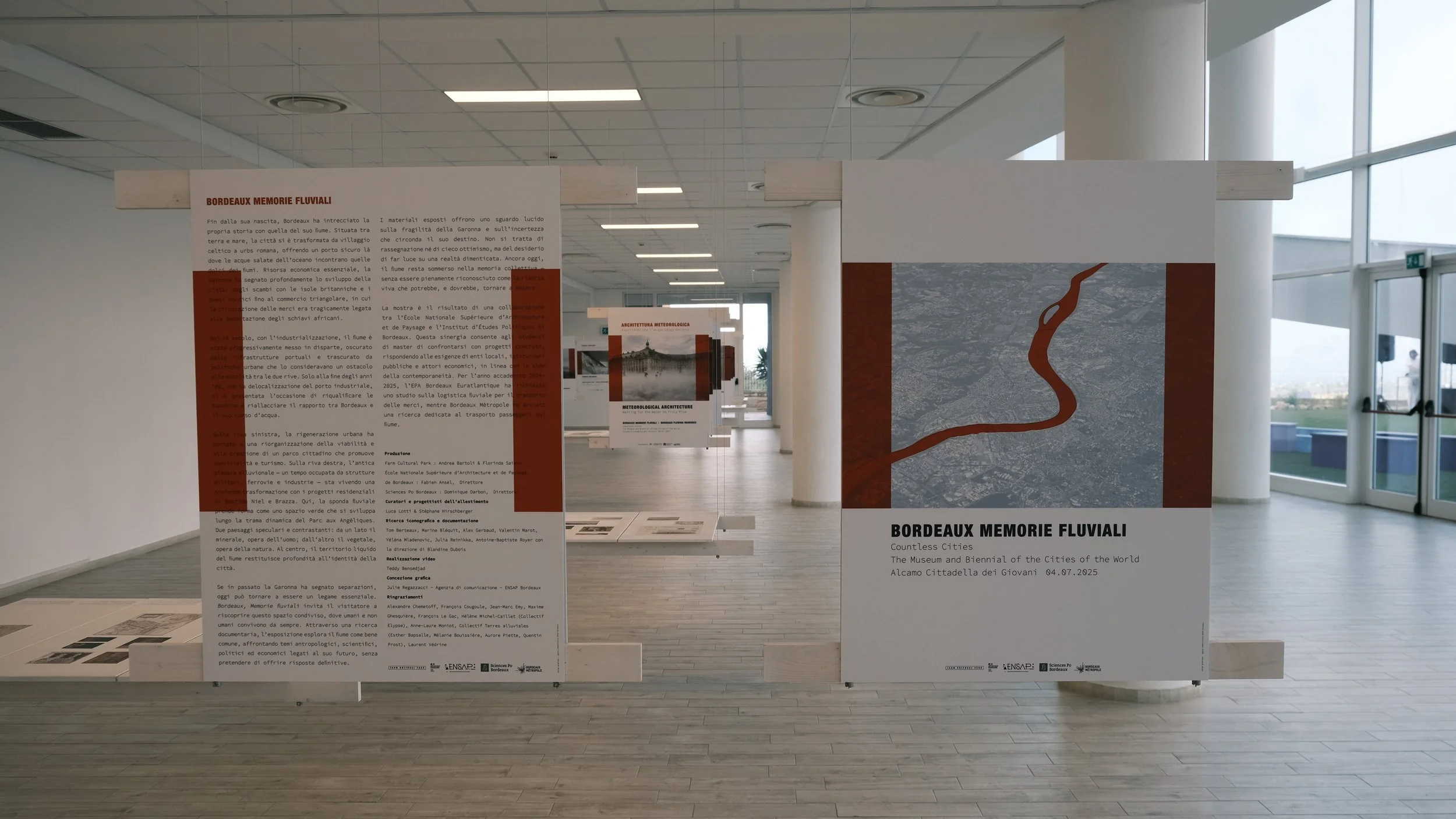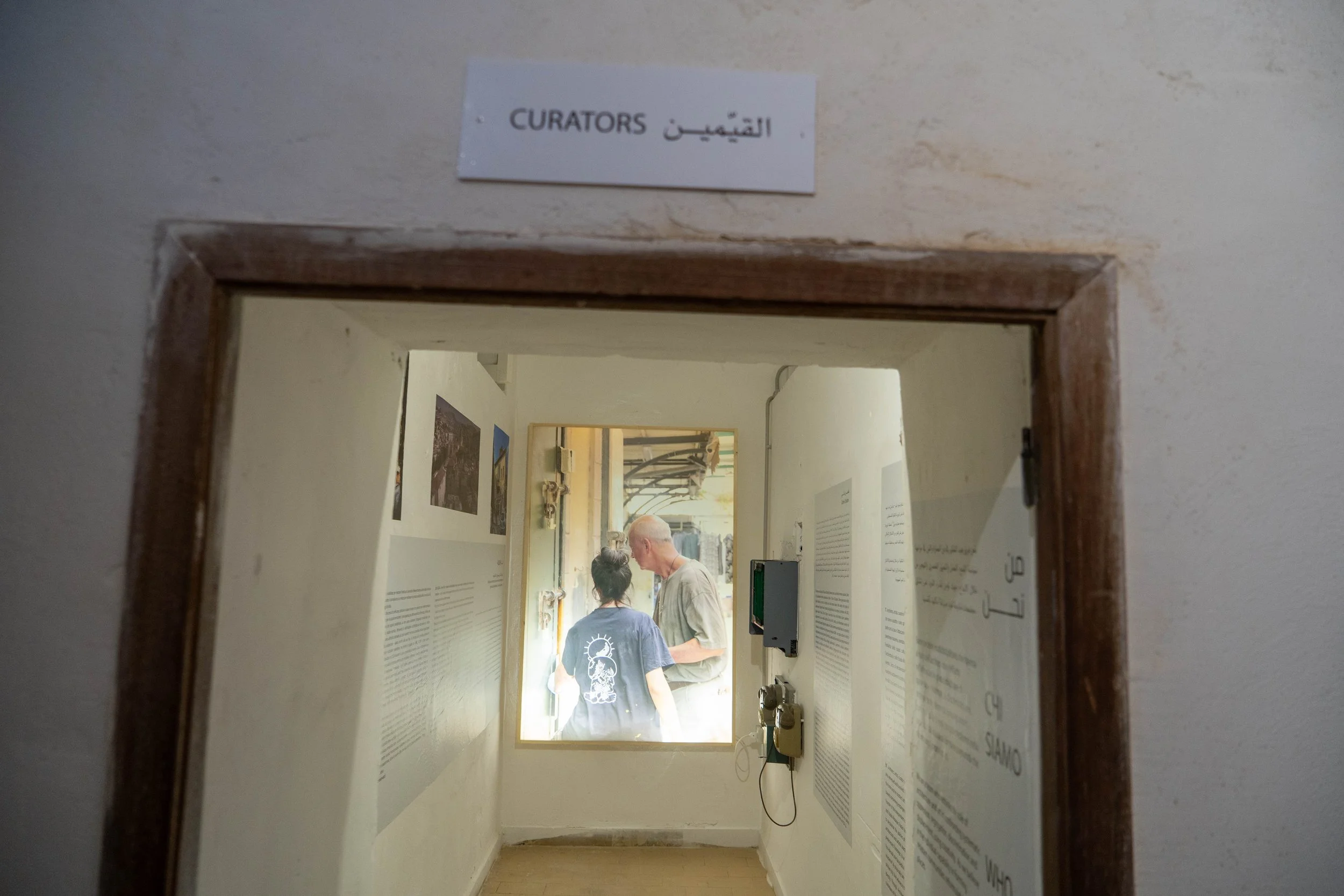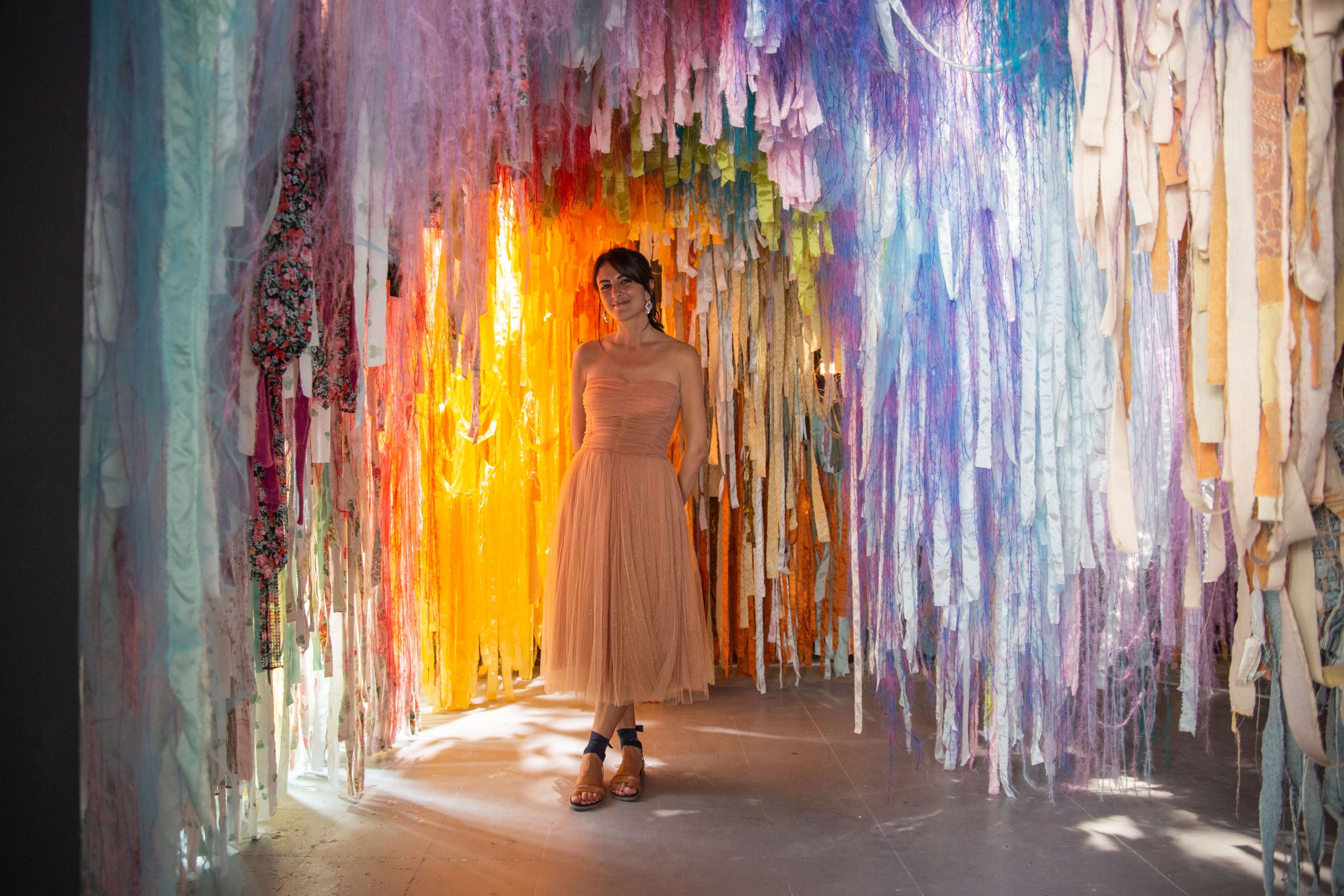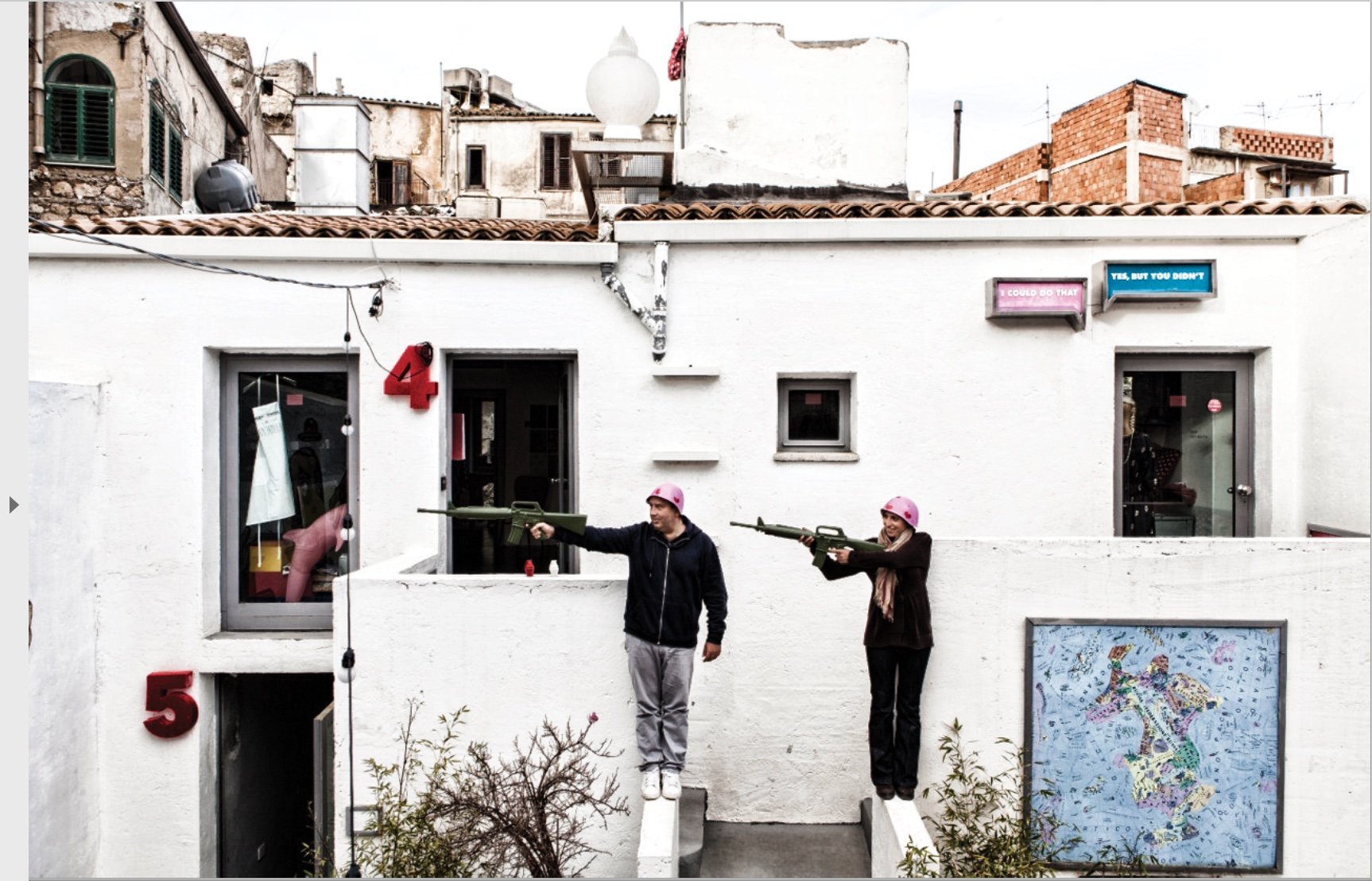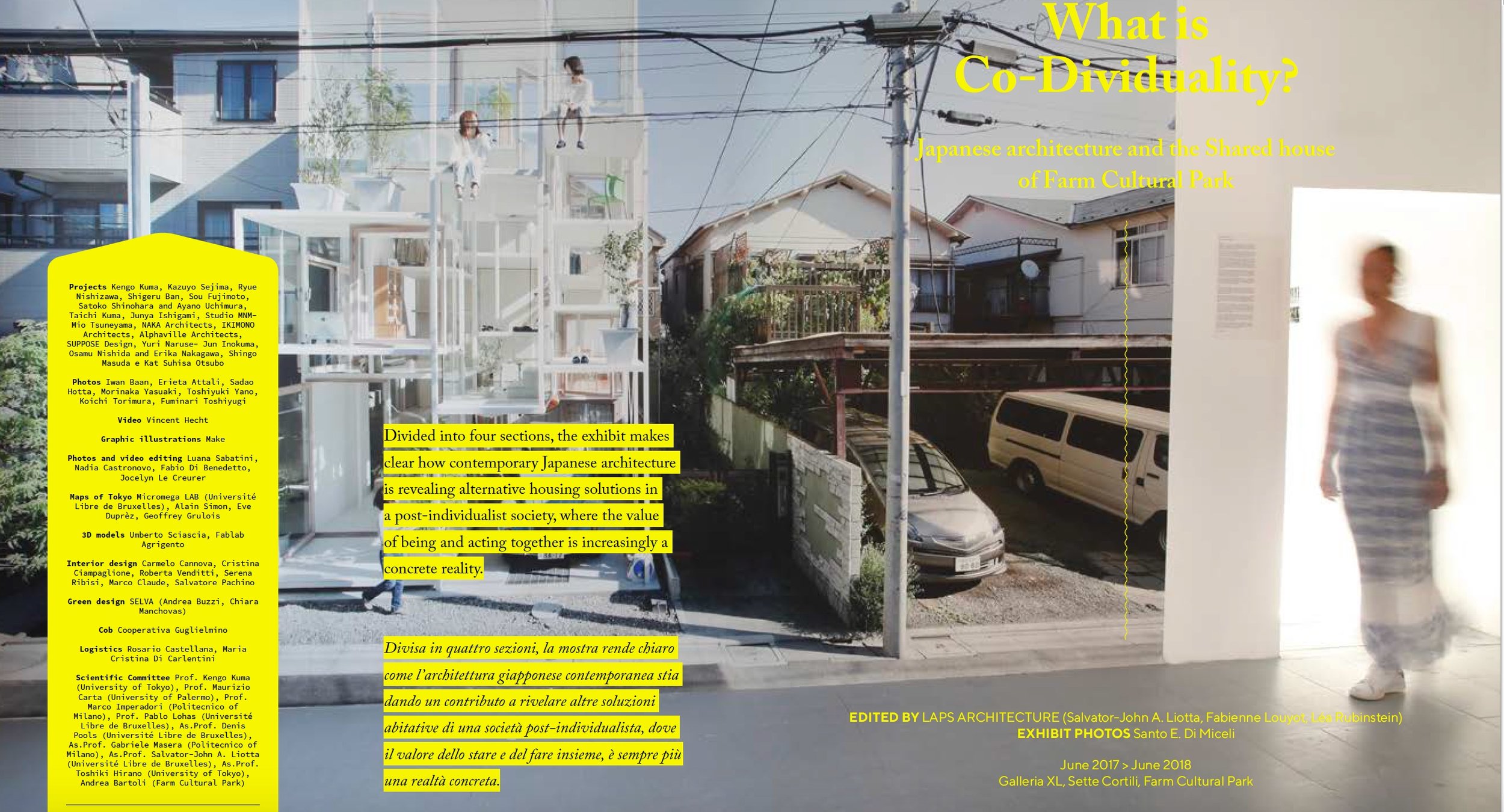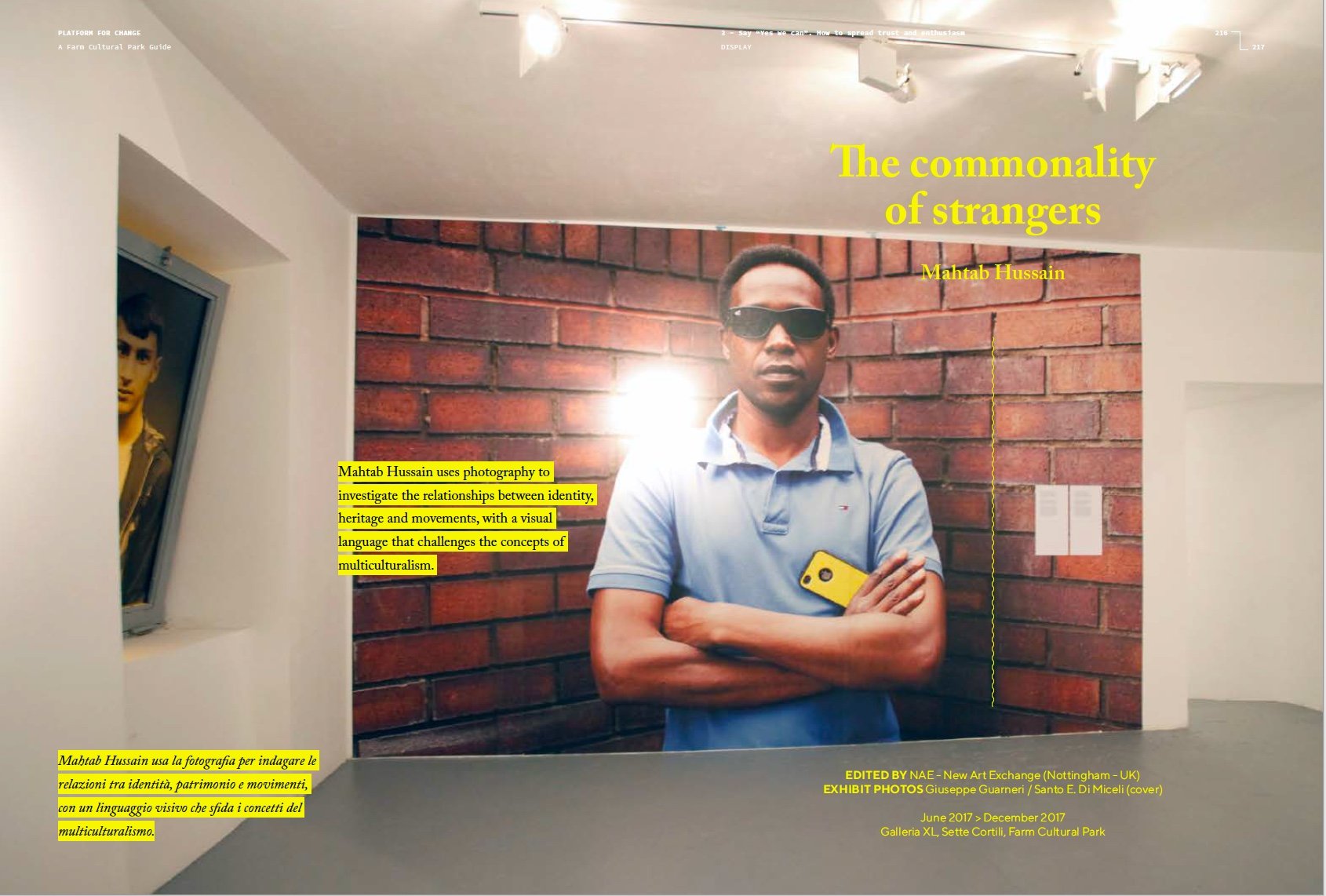Andrea Bartoli
“Our exhibitions consider how art can inspire change about sustainable cities and communities, gender racial and ethnic justice, creativity and free expression, civic engagement and government, urban regeneration and climate change, future and society”.
«Le nostre mostre riflettono su come l’arte possa ispirare cambiamenti riguardo a città e comunità sostenibili, giustizia di genere, razziale ed etnica, creatività e libertà di espressione, impegno civico e governance, rigenerazione urbana e cambiamento climatico, futuro e società.»
CURRENT
L’Office du Dessin by Olivier Garraud
CITTADELLA DEI GIOVANI - ALCAMO - July 4, 2025 – May 30, 2026
“L’Office du Dessin” by French artist Olivier Garraud is a graphic project that uses drawing as a critical tool to challenge the excesses of capitalism.
Bordeaux Pavilion
CITTADELLA DEI GIOVANI - ALCAMO - July 4, 2025 – May 30, 2026
The Bordeaux Pavilion explores the relationship between the city and its river, the Garonne—an essential lifeline and a shared space between humans and non-humans. The project, the result of a collaboration between the Bordeaux School of Architecture and Landscape and the Institute of Political Studies of Bordeaux, investigates the river through the lenses of memory, logistics, imagination, and a sustainable future.
Curator: Luca Lotti, and a collaboration between the Bordeaux School of Architecture and Landscape and the Institute of Political Studies of Bordeaux.
Nazareth Pavilion: I will never leave my house ALIVE
EX CARCERE SAN VITO - AGRIGENTO - June 28, 2025 – May 30, 2026
This Pavilion explores Palestinian persistence through spatial resistance, memory, and the enduring bond to home: to live is to stay — نحيا لنبقى. Inspired by the curator’s father' s deep attachment to his home, a Nakba survivor, it reflects on the ongoing erasure of Palestinians. In 1948, over 500 villages were destroyed, and 750,000 indigenous palestinian displaced to enable a “pure democratic Jewish state” on stolen land —this is the Nakba, planned by Britain and the West. Today, the world watches the second Nakba unfold. In Nazareth, under Israeli occupation, hidden displacement policies continue. Architecture conceals disappearance, while heritage homes are abandoned, ruined, and forgotten. Yet in this invisibility lies resistance — the "power of invisibility." The Pavilion visualizes the strong connection between Palestinians and the house. More than a refuge, it is "the soul of Palestinians" — an enduring symbol of steadfastness and resistance. This bond forms an “architecture of resistance” — when the house is taken, the land is lost forever. Through photography, a sonic map, and installations, the Pavilion unveils hidden connections between sound and architecture, emphasizing the disrupted urban fabric. It reveals architectural distortion, crumbling historic buildings, and new layers of Palestinian identity, shaped in response to colonization. The exhibition reimagines decolonization through architecture —by coexisting with violent structures, reusing concealment to shield heritage from surveillance. The Pavilion rethinks resistance by addressing the Palestinian struggle for existence. Preserved architectural heritage can be a tool to reweave the hidden — transforming invisibility into visibility — whereas the collapse and distortion of traditional houses become a defensive means of protection while remaining invisible. This practice navigates between presence and absence; appearance and disappearance; sound and silence; mobility and immobility; resistance and powerlessness; harmony and dissonance. It invites reflection on the "power of absence", where invisibility becomes a form of immunity in the face of denied sovereignty. The Pavilion invites reflection on “the power of absence”: when sovereignty is absent, invisibility becomes immunity.Should Palestinians remain imprisoned? — Unseen and Unheard? And by whom do we demand recognition? Is 108 years of settler-colonialism still "complicated"or ”conflict” or even a “war”?, or is it clear and simple: an ongoing crime, where the western hegemony completes the ethnic cleansing of Palestinians to protect its Zionist project?
Curators: Razan Zoubi Zeidani and Daher Zeidani; Sound piece Dirar Kalash; Project coordinator Eleonora D’Alessandro; Organizational support Giada Ciavattella, Federico Bartoli Felter Fabrizio La Bella, Daniele La Bella; Graphic design FIONDA Torino; Video Art editors Rama Moussa and Razan Zoubi Zeidani; Sonic map website developer Rana Daoud; Weaving workshop Rula Qubti; Weaving workshop participants Wafaa’ Fahoum Zoubi , Samia Abu Ahmad, Rehab Nassar; Copper artwork Jewelry designer Hadeel Kanj; Robotics engineer Shadi Gnayem; With the support of Farm cultural Park, Culture resource (Wijhat), AFAC- Arab Fund for Art and culture; Projects involved: FAZZA - urban rehabilitation, ALDAR for research, art and architecture, A journey of sounds reclamation; Photography and videography Razan Zoubi Zeidani, Daher Zeidani, Rama Moussa; Special thanks Fuad Khadir Zoubi - Concept inspiration, Wafaa’ Fahoum Zoubi - Concept inspiration and Al Souk residents and stakeholders.
Medellín Pavilion
The Medellín Pavilion will be a dreamlike narrative about the recent transformation of the Colombian city. Once one of the most dangerous cities in the world, it has become a model of social urban planning and high-value public architecture. A system of suspended bamboo elements will metaphorically represent the city’s natural morphology: a wide valley hosting a metropolis of five million inhabitants. A symbolic representation of the river that flows through the heart of the valley—the backbone of the city—will also be featured, along with its numerous tributaries: blue ribs resembling streams combing through the urban settlements.
Curators: Luca Bullaro, Jorge Torres, Giovanna Spera, Horacio Valencia.
With the support of the Universidad Nacional de Colombia and the Municipality of Medellín.
Gang's Country: The Reality of Gangs in Haiti and the Struggle for Change
EX CARCERE SAN VITO - AGRIGENTO - June 28, 2025 – May 30, 2026
In 2024, Haiti faces an unprecedented humanitarian crisis: over 5.5 million people are in need of assistance, with more than 1 million internally displaced and 4.4 million suffering from severe food insecurity. Gang violence has brought hospitals, schools, and transport to a standstill, disrupting education for over one million children and leading to a dramatic increase in sexual violence, particularly against women and minors. The healthcare infrastructure is collapsing, while epidemics like cholera continue to spread. Humanitarian intervention is hindered by insecurity, lack of funding, and a fragmented government. International organizations are calling for an urgent, resilient, and sustainable response.
This exhibition seeks to give voice to the Haitian people, telling the story of a tragedy too often forgotten.
Curator: Carla Bartoli – President of RING Scientific Curator: Scientific Curators: Lena Ciganer; Participating Creatives: Haiti: Words against Bullets Directors: Charles Emptaz, Olivier Jobard – Produced by TV ONLY – France, 2024 – ARTE; Reference texts and publications: Jake Johnston – AID STATE
South Korea Pavilion
A story of a land of contrasts, the South Korea Pavilion portrays a country that offers a wide range of experiences to visitors—from ancient traditions still alive in the rural villages to the resistance against the most advanced forms of modernity.
The Pavilion is curated by Renzo Lecardane, Zeila Tesoriere, Paola La Scala (University of Palermo), Inhee Lee, Jaehoon Chung, Yoonjeong Kim (Pusan National University, South Korea), Mladen Jadric (Vienna University of Technology, Austria), Silvia Serreli, Gianfranco Sanna, and Giovanni Maria Biddau (University of Sassari).
The Congo Wars: The Persistence of Ethnic Divisions and Violence
SETTE CORTILI - FAVARA - June 27, 2025 – May 30, 2026
The Democratic Republic of the Congo (DRC) has experienced ethnic conflicts and foreign interventions since its decolonization. Natural resource wealth and ethnic tensions have fueled a series of wars, particularly during the Congo Wars, which saw the involvement of armed groups from neighboring countries, such as Rwanda. The 1994 Rwandan genocide and the subsequent emergence of the M23 movement further deepened ethnic fragmentation, intensifying conflict in the North and South Kivu provinces. Despite international interventions, including those by the United Nations, and various peace efforts, violence continues. This Pavilion explores how the genocide and the rise of M23 exacerbated ethnic divisions, and why peace resolutions have failed. It also examines current humanitarian interventions and the evolving nature of the conflict in the region, offering an overview of the present state of the crisis.
Exhibition Venue: Farm Cultural Park Favara – Sette Cortili, Farm XL
Curator: Carla Bartoli – President of RING Scientific Curator: Scientific Curators: Laura Ridoux; photo Guerchom Ndebo; Beni Files Produce Het Peloton – Congo 2017 -JourneymanTV
Khartoum Pavilion
Climate, Chaos and Conflict: Political Instability in the Sahel
SETTE CORTILI - FAVARA - June 27, 2025 – May 30, 2026
In the heart of the Sahel, Sudan is experiencing the dramatic consequences of both climate and political instability. Climate change exacerbates resource scarcity, fueling ethnic tensions and armed conflict. This pavilion explores the connection between environment and warfare, and the humanitarian challenges that arise from it. A journey through resilience, forced migration, and the struggle for survival. The pavilion is based on the research of Beatrice Baldi and coordinated by Carla Bartoli from RING.
Exhibition Venue: Farm Cultural Park Favara – Sette Cortili, Farm XL
Curator: Carla Bartoli – President of RING Scientific Curator: Beatrice Baldi; The Elephants and the Grass Producer: Philamedia 2023 – JourneymanTV; Key Texts and Publications: Jean-Loup Amselle – The Invention of the Sahel - Edoardo Baldaro – Sahel: Geopolitics of a Crisis. Jihadism, State Fragility, and International Intervention
The Gaza Genocide
One of the most severe humanitarian and moral catastrophes of our time
PALAZZO TORTORICI - MAZZARINO - June 20, 2025 – May 30, 2026
While the world watches – too often in silence – the Palestinian people are facing one of the gravest humanitarian and moral catastrophes of our time.The Gaza Genocide is an exhibition of denunciation and remembrance that, through photographs, audiovisual materials, direct testimonies, and geopolitical analysis, documents the ongoing horror in the Gaza Strip. With over 49,000 dead, 2 million displaced, and an entire generation deprived of education, homes, and a future, Gaza today is the symbol of a genocide happening in real-time, under the eyes of the world. It is a visual and sound journey into the everyday life of a population stripped of every basic human right. It is the story of a genocide that risks spreading into an increasingly unstable regional geopolitical context. The Gaza Genocide is not just an exhibition: it is an act of cultural resistance, a clear stance, an invitation to not look the other way.
Exhibition venue: Farm Cultural Park Mazzarino – Palazzo Tortorici, Corso Vittorio Emanuele 408
Curator: Carla Bartoli – President of RING Scientific Curators: Una Ines and Davide Russello Participating Creatives: Haitham Emad – Palestine ; Mohamed Yaghi - Gaza Sound Man – Palestine; Mahmoud Atassi - Eyes of Gaza – Syria-Turkey Reference texts and publications:Ahmed Alnaouq – We Are Not Numbers: The Voices of Gaz
Varanasi: A Journey into the Infinite
VILLA GENUARDI - AGRIGENTO
Curated by Farm Cultural Park, with a photographic reportage by Andrea Marchegiani and a video contribution by Salvatore Izzo, the exhibition will offer a visual and sensory journey through one of the oldest and most mysterious cities in the world. Varanasi, also known as Benares, is a unique center of spirituality and culture, where the sacred and prayer mark the most important moments of the day and the lives of all the faithful. Visitors will be guided through an immersive experience that reveals the city in its contrasts: from the lively alleyways, to the temples, to the ghats along the Ganges, and the sacred ceremonies and daily cremations. The exhibition invites reflection on the essence of a city that, as the title suggests, seems to escape time and the limits of the finite.
The project is funded by the Sicilian Region and realized in collaboration with the Municipality of Agrigento, the Valley of the Temples Park, the Superintendency of Cultural Heritage of Agrigento, and the Municipality of Aragona.
New Cities, built from scratch: Astana, Forest City, Nusantara, Songdo, e The Line
AUDITORIUM INCOMPIUTO- ARAGONA
Curated by Analogique and Farm Cultural Park, this exhibition project for Agrigento Capitale 2025 is funded by the Sicilian Region and realized in collaboration with the Municipality of Agrigento, the Valley of the Temples Park, the Superintendency of Cultural Heritage, and the Municipality of Aragona. Each city represents a visionary response to contemporary urban issues, from the smart city technologies of Songdo to the radical verticality of The Line in Saudi Arabia. Through installations, videos, and images, the Pavilion unveils the promises and challenges of these urban utopias, questioning how truly sustainable and inclusive their development models are. Hosted within a public work left unfinished for thirty years in Aragona, the exhibition invites visitors to reflect on how cities built from scratch could represent the future or risk turning into social and environmental dystopias. It will be a unique opportunity to explore the hidden aspects of these futuristic projects and ask: how can we build cities that are truly human-centered? With special participation by Filippo Venturi.
UPCOMING
Radical SHE
Women Quadrennial of Art and Society
January 1, 2026 - December 31, 2026
One year of exhibitions, installations, performances, labs, workshops, lectures, and talks to explore gender equality, female empowerment, and leadership through art and creativity.
Agata by Rosangela Leotta
PAST
2024 first edition
Abbiamo tutto, manca il resto!
Mazzarino - May 12, 2024 - June 22, 2025 /Favara June 21, 2024 - June 22, 2025
Farm Cultural Park presents "We have everything, we lack the rest!" the first edition of a transdisciplinary four-year event dedicated to Sicily "to its everything" and "to what is not there", an exhibition that with different pavilions will also read the territory and the local art scene "with external eyes".
ARTISTS IN MAZZARINO: LORENZO ROMANO E AZZURRA MESSINA – LIGAMA - ANNE-CLÉMENCE DE GROLÉÈ - CARMELO NICOTRA - ROBERTO COLLODORO - FABIO ALFANO CALOGERO PALACINO . WITH THE SPECIAL PARTICIPATION OF THE MAYER PAVILION COLLECTIVE FROM BERLIN, A PROJECT CURATED BY ANDREA MINEO WITH GUEST ARTISTS RACHEL HARRIS - SANDRA CHRZANOWSKI - LUÏZA LUZ - ANDRIES DE LANGE - VINCENZO FIORE MARRESE
ARTISTS IN FAVARA: AGNESE CANICATTÌ - ANGELO DE GRANDE - ANGELO SALEMI - ANTONIO PANARISI - CARMELO NAVARRA - DANILA MANCUSO - GIOVANNI IUDICE - GIUSEPPE AREZZI X NEROSICILIA - GIUSEPPE DE MICHELE - GIUSEPPE VENEZIANO -JÉRÉMY DEPUYDT AND GIUSEPPE ACCARDO - LOREDANA LONGO - LORENZO MANISCALCO - LORENZO ROMANO AND AZZURRA MESSINA - ALESSANDRA RIGANO AND ELISA RACITI OF THE AVAJIA COLLECTIVE FOR MAREA - MARCO SICILIANO - MARIA DONATA BOLOGNA - NUUCO - GIUSEPPE GUERRERA - ROBERTO CACCAMO - SALVATORE CAPPELLO - NEU [NÒI] - TRANSITION FOR - VLADY - VANESSA ALESSI + JOHN BLOND - ALESSIA GATTUSO
WITH THE SPECIAL PARTICIPATION OF: ALTERAZIONI VIDEO, ANALOGIQUE, FOSBURY ARCHITECTURE FOR THE UNFINISHED AUDITORIUM OF ARAGONA
EUROPEAN DIRECTORS' COLLECTIVE MOVIMENTO OFICINA DE CINEMA COLABORATIVO
STUDENTS AND PROFESSORS' COLLECTIVE FROM WOODBURY SCHOOL OF ARCHITECTURE IN LOS ANGELES
Utopia
Dreaming the Impossible by Carlo Bevilacqua
Farm Cultural Park Favara , Apr 26, 2023 - May 28, 2024
A visual journey which explores - from India and Singapore to Vancouver Island, Canada, across Europe and the United States - the world of utopian communities, ( alternative, spiritual, artistic, hippie, environmental) together with individual initiatives which embody the utopian spirit. Auroville, Sadhana Forest, Can Masdeu, Christiania, Damanhur, Marinaleda, Earthship, Elves,Vieille Valette, Freedom Cove, Yogaville, Twin Oaks. These are some of "Utopias" described in this long terms work and in the book. The project documents and try to understand how these communities, born decades ago, have evolved and how they managed to survive to the pressure of our dominant culture .

